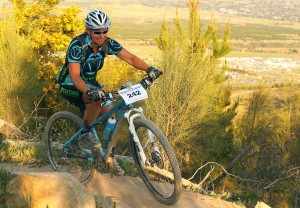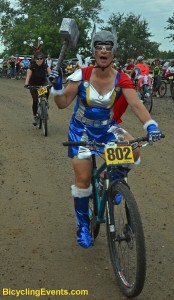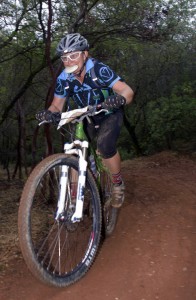
Yvette Crockell raced to second place at the World’s in Canberra, Australia. She hopes to move up a position in Weaverville.
Few 24-hour racers are as enthusiastic as Yvette Crockell. When the 50-year old Northern California pharmacist and mother of two was asked to be interviewed for this series, her response was “Who’d want to read about some crazy lady who’s done twenty-two 24-Hour races?”
Interestingly the first of her 22 races happened nearly four decades ago. She explained, “There was a 24-hour bike race in Tulsa, Oklahoma back when I was 12 years old. It was charity challenge thing that only went on for two years. I did it both times. You’d go out and do this 32 mile road loop first then come back and do laps on a paved 1-mile course they’d set-up around this old mall in Tulsa. You wore this bib that they’d stamp after every lap.” The first year she logged a fair number of miles, but fell well short of her goal of riding the entire time, “I fell asleep, but vowed the next year to stay awake.” She did just that, “I remember having my name in the paper for logging the most miles!”

Yvette doesn’t take herself too seriously, as demonstrated by the race kit she chose for a local event.
Crockell has been an avid mountain biker for most of her adult life and for years her free time has centered on riding, training and racing. She started in cross-country but eventually focused more in longer events, “I’ve done 48 endurance races of eight hours or greater,” she revealed. Her first 24-hour mountain bike racing came in 2005, “A friend was supposed to be on a team but couldn’t go so I took her place and met this group of women and had a great time. During that race I remember watching the solos and thinking, ‘Wow, what a cool and inspiring thing!’” She soon found herself joining other teams for endurance events and eventually in 2007 she reached a turning point while competing on a 2-rider team. “I was on this hill and came up on this guy who was racing solo on this beater bike with an empty child-seat on the back. It turned out that he was riding in memory of his 4-year old daughter—she’d died and he’d vowed that he would ride as many charitable events as he could for her. He was riding on the bike that he used to ride with her. And that was when I said ‘Okay, next year I’m doing a 24-hour solo.”
The following year she fulfilled that promise to herself. But at 24-hour solo debut there was heavy rain, “There was more than four inches of rain! People’s brakes and drive-trains were going away but I managed to keep going.” One by one the other women in her category dropped out, “But I kept going and ended up winning. I thought ‘If I can keep going through all that, I should keep doing these.’”

Yvette believes that during an endurance race anything that can be done on the bike should be. “You work so hard on course to gain a few seconds here or there. Why give it up by lollygagging in the pits? My goal for pit stops is to be in and out in under a minute.”
Her first World’s was 2009 in Canmore, Canada where she took fourth in her age group. “The next year was Canberra, Australia. I took second. So I hope that my World’s trend continues—I’m hoping to win!” If course experience is any help, she may meet that gold medal goal, “I’ve raced at Weaverville at least five times. I love Weaverville!,” she said, “You’re going to laugh, but my favorite part of that course is when you reach the green gate (at the top of the main climb). When you get to the top you know you’ve conquered something great! ‘Yeah! I’ve done it again!’ And then you hit the downhill and all that singletrack is so fun and so amazing!” She continued to share another favorite Weaverville memory, “One year it was really hot and there were cases of water put out all along the side of the road going up the climb. The riders were told ‘We don’t care if you drink the water, pour it over your head or bathe in it. We just want you all to use it.’ And I know I sure did! I used those cases of water as short-term goals too, ‘Three hundred yards to the next one, three hundred yard to the one after that,’ all the way up the mountain.”
Yvette Crockell is a prime example of what makes endurance mountain bike racing so great. For every elite racer who’ll push to 101.2% for the entire 24 hours there are dozens of racers like Yvette who are in it for the sheer fun and the personal challenge. These weekend warriors who somehow manage to juggle their working hours, their family hours and their training hours to put themselves on the starting line a few times a year are the heart and soul of this wonderful sport.
#weaverville24 #wembo2015 @world24hr